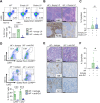Natural killer cells act as an extrinsic barrier for in vivo reprogramming
- PMID: 35420133
- PMCID: PMC9124575
- DOI: 10.1242/dev.200361
Natural killer cells act as an extrinsic barrier for in vivo reprogramming
Abstract
The ectopic expression of the transcription factors OCT4, SOX2, KLF4 and MYC (OSKM) enables reprogramming of differentiated cells into pluripotent embryonic stem cells. Methods based on partial and reversible in vivo reprogramming are a promising strategy for tissue regeneration and rejuvenation. However, little is known about the barriers that impair reprogramming in an in vivo context. We report that natural killer (NK) cells significantly limit reprogramming, both in vitro and in vivo. Cells and tissues in the intermediate states of reprogramming upregulate the expression of NK-activating ligands, such as MULT1 and ICAM1. NK cells recognize and kill partially reprogrammed cells in a degranulation-dependent manner. Importantly, in vivo partial reprogramming is strongly reduced by adoptive transfer of NK cells, whereas it is significantly increased by their depletion. Notably, in the absence of NK cells, the pancreatic organoids derived from OSKM-expressing mice are remarkably large, suggesting that ablating NK surveillance favours the acquisition of progenitor-like properties. We conclude that NK cells pose an important barrier for in vivo reprogramming, and speculate that this concept may apply to other contexts of transient cellular plasticity.
Keywords: Immune system; Mouse; NK receptor ligands; Natural killer cells; Organoids; Plasticity; Pluripotency; Reprogramming.
© 2022. Published by The Company of Biologists Ltd.
Conflict of interest statement
Competing interests M.S. is shareholder of Senolytic Therapeutics, Rejuveron Senescence Therapeutics and Life Biosciences.
Figures







References
Publication types
MeSH terms
Substances
LinkOut - more resources
Full Text Sources
Molecular Biology Databases
Miscellaneous

